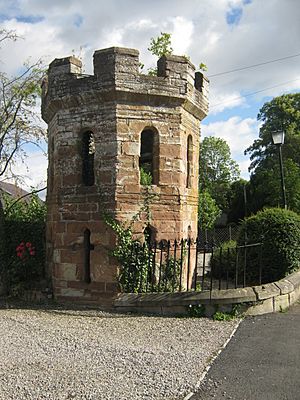Dingwall Castle facts for kids

Dingwall Castle was an important medieval castle in the town of Dingwall, in eastern Scotland. People think it was first built by Norse settlers around the 11th century. This means it's been around for a very long time!
Contents
Dingwall Castle in Scotland's Wars
During the Wars of Scottish Independence, English soldiers working for King Edward I of England took control of Dingwall Castle. But it wasn't long before Scottish forces, led by Uilleam II, Earl of Ross, captured it back for their king, Robert I of Scotland (also known as Robert the Bruce).
From this castle, the Earl of Ross gathered his men from the Ross area. They went to fight against the English at the famous Battle of Bannockburn in 1314. This was a huge victory for Scotland! As a thank you, King Robert gave Dingwall Castle and the town of Dingwall to the Earl of Ross in 1321.
A Castle Duel
Around the early 1400s, an exciting story tells of a duel that happened near the castle. The castle's governor, who was in charge for Robert Stewart, Duke of Albany, had an argument with a man named Thomas Munro. Thomas was the brother of Hugh Munro, 9th Baron of Foulis, who was the chief of Clan Munro.
The two men met in a nearby village. Their argument quickly got heated, and they pulled out their daggers, called dirks. In the fight, Thomas Munro sadly killed the governor of Dingwall Castle. Some records say the governor was "assassinated" and then a new person from Clan Mackay took over.
When the Lord of the Isles Took Over
In 1411, Domhnall of Islay, Lord of the Isles, who was the chief of Clan Donald, captured Dingwall Castle. He did this because he wanted to become the Earl of Ross. This happened just before another big battle called the Battle of Harlaw.
Later, in 1438, the next Clan Donald chief, Alexander of Islay, Earl of Ross, was officially recognized as the Earl of Ross. He then lived at Dingwall Castle. However, his son, John of Islay, Earl of Ross, wasn't as lucky. The title of Earl of Ross was taken away from him in 1475. This meant the castle became a royal castle again, belonging to the king.
After that, different people were put in charge of the castle. John Munro, 11th Baron of Foulis was one governor, followed by Andrew Munro. In 1488, Sir James Dunbar became the governor.
Changes in the 1500s
In 1507, Andrew Stewart, who was a Bishop of Caithness, made some improvements to the castle. This was after it had been attacked by the MacDonalds and Mackenzies.
Over the years, many other important people were governors of Dingwall Castle. These included John Stewart, 2nd Earl of Atholl, John Earl of Moray (who was the brother of King James V of Scotland), and George Munro. Later, Sir Andrew Keith and Sir John Preston also held the position.
The Castle's Downfall
Around the year 1600, the royal family stopped taking care of Dingwall Castle. It slowly started to fall apart and become a ruin. After King James VI of Scotland passed away in 1625, no one maintained the castle anymore.
People even started using the castle stones to build other things! By 1817, most of the castle was completely gone. Today, only a few small pieces of the original castle remain. These remains are protected as a special historical site.
A Secret Tunnel?
There's a story that a tunnel once ran from Dingwall Castle all the way to the basement of nearby Tulloch Castle. This tunnel has now collapsed, so you can't walk through it. But if you look closely, you might be able to see a small opening or air vent on the lawn of Tulloch Castle, which is said to be part of this old passageway!
Images for kids


